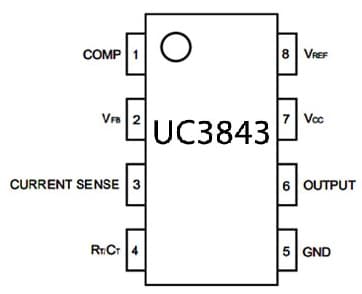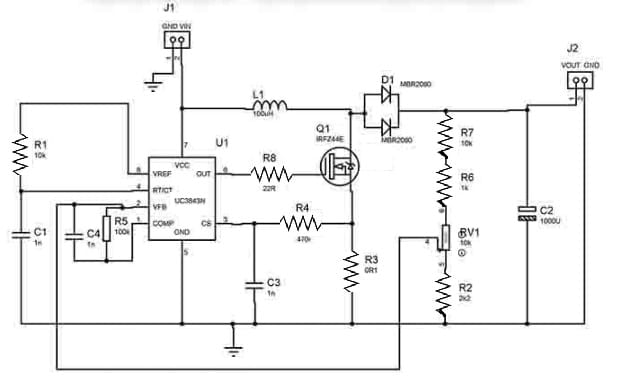UC3843 IC is a revolutionary current-mode PWM controller IC, designed for optimizing power management within your electronic systems. So this is an extremely efficient integrated circuit that ensures exact control above the power supply, decreasing energy waste & improving the performance of the device. This IC provides stability and superior regulation which makes it a perfect choice in different applications. This controller reduces power loss and increases energy efficiency. So its robust design guarantees long-term reliability which makes it a dependable IC within demanding environments. This IC assurances consistent and reliable power management when developing industrial equipment or consumer electronics. This article overviews the UC3843 PWM controller, pinout, specifications, and applications.
What isUC3843 PWM Controller?
UC3843 is a current-mode PWM controller which means it provides a stable current by changing the output voltage toward the load. It is designed especially for DC-to-DC converters as well as offline applications. This controller IC uses the least requirement of external components to perform its tasks by avoiding complexity. So it is the most commonly used PWM controller IC because of its unique features like; high gain amplifiers, current sensing, and high current totem pole out for the MOSFET control.
There are commonly two control modes are used when designing switch mode supplies through feedback like voltage mode control and current mode control. So, voltage mode control is used where the o/p voltage is kept stable regardless of the current and the current mode is used where the o/p current will be constant regardless of the voltage.
This IC can be used to limit or control current within applications like RPS, Line voltage regulators, SMPS, DC-DC Converters, and many more. So if you are searching for a PWM IC to generate PWM signals for a power switch control based on the current supplied throughout the circuit then this PWM IC might be the correct choice for you.
Working
The UC3843 IC is a pulse-width modulation controller that works by controlling a buck-boost converter. So it works in either boost or buck mode based on the i/p and o/p voltage necessities. The UC3843 IC in buck mode changes the output voltage by simply controlling the switching transistor’s duty cycle within the buck converter circuit. So this allows it to reduce the input voltage to the preferred output voltage.
The UC3843 IC in boost mode changes the output voltage, however this time by controls the duty cycle to increase the input voltage to the necessary output level. So it can be done by monitoring the o/p voltage and regulating the switching transistor duty cycle.
The UC3843 IC samples the output voltage & evaluates it to a reference to produce the PWM signal that drives the power switch. So this feedback loop maintains the output voltage adjusted despite changes within load (or) input voltage.
UC3843 PWM Controller Pin Configuration:
This PWM Controller IC includes 8 pins where each pin and its functionality is discussed below.

UC3843 IC Pin Configuration
- Pin-1 (COMP/Comparator): It is an o/p pin that is connected normally to the voltage feedback pin through the resistor & capacitor. This pin provides a 1MHz low-impedance single based on the variation between the set & current voltage.
- Pin- 2 (VFB or Voltage Feedback): This pin is an input to the error amplifier within the IC. So the variation within the voltage level is provided to this pin.
- Pin- 3 (Current Sense): A shunt resistor is utilized to monitor the current throughout the circuit & the voltage across it is given as feedback toward the current sense pin.
- Pin- 4 (RT (Timing Resistor) or CT (Timing Capacitor): This IC includes an internal oscillator which can be set with an external resistor & capacitor which are connected to this pin.
- Pin-5 (GND): This pin is connected to the GND of the circuit.
- Pin-6 (Output): This pin outputs the pulse width modulation signal depending on the feedback given & we can utilize this pin to switch the power electronic device.
- Pin-7 (Vcc): This is a voltage supply pin for the IC.
- Pin-8 (VREF): This is a Reference voltage pin based on which the pulse width modulation signal is generated.
Features & Specifications:
The features and specifications of the UC3843 PWM controller include the following.
- UC3843 IC is a current-mode PWM controller.
- This IC includes 8 pins.
- Its operating voltage ranges from 7.0V – 8.2V.
- The high o/p voltage is 13.5V.
- The output pin current is 1A.
- The Max source current is 22mA.
- Analog input ranges from -0.3 to 6.3 volts.
- Its gain is 3V.
- Its typical oscillation frequency is 52.
- Its low o/p voltage is 0.08V.
Equivalent and Alternative PWM Controller ICs
The equivalent UC3843 PWM controller IC is UC3842 whereas alternative PWM controller ICs are; UC2842, SG2524, and UC3844.
DC to DC Boost Converter with UC3843 PWM Controller
Here, we are going to explain how to design a DC-to-DC boost converter with the UC3843 PWM controller IC using the required components. The required components to make this DC to DC boost converter circuit mainly include; jumper wires, UC3843 IC, MBR2060CT Diode, IRFZ44 MOSFET, 100uH Inductor, 1n Capacitors, 10k Trimpot, 0.1R 5W resistor, 470R Resistor, 10k Resistors, 1000u 50V Capacitors, 22R Resistor, 2K2 Resistor, 100k Resistors, and 2 x 2 Pin Terminal Block. Connect the circuit as per the diagram shown below.

DC to DC Boost Converter with UC3843 IC
Working
The major components used in this circuit mainly include; UC3843 PWM Controller IC, IRFZ44 MOSFET, MBR2060CT Diode, 100uH Inductor, and 10k Trimpot which are discussed below.
UC3843 IC
The UC3843 is a flexible PWM controller IC, used widely in DC-to-DC converters. But it is designed mostly for power supply applications & it provides a variety of features like soft-start capability, overvoltage protection & internal temperature compensation. This PWM IC functions at a 50 kHz fixed frequency to ensure efficient and stable operation of the converter.
This IC includes an error amplifier, a voltage reference, a PWM comparator, an oscillator & a driver used for the external MOSFET. UC3843 IC is available in different packages which include; SOP, TO-220 & DIP. This IC needs external components like capacitors, resistors, and an inductor to design the circuit.
Thus, the UC3843 IC is a versatile controller compatible with buck-boost power conversion topologies implementation wherever both step-up & step-down capabilities are required. It has an integrated control feature which simplifies the switching power supplies types design.
IRFZ44 MOSFET
This is a very popular N-channel enhancement-mode-based power MOSFET which is utilized as the switching element within the boost converter circuit to adjust the voltage. This MOSFET includes a low on-resistance, which provides high efficiency and less power losses. It can also handle 49A of a max drain current & can sustain up to 55V voltage.
This MOSFET needs an appropriate heat sink to dissolve the produced heat throughout the operation. So it is essential to choose a heat sink with sufficient thermal conductivity to avoid overheating. This MOSFET can be driven easily by the IC using a pull-up resistor & gate resistor.
MBR2060CT Diode
The MBR2060CT Schottky barrier rectifier diode is used commonly in boost converters. This diode’s less forward voltage drop ensures high efficiency and the least power dissipation. It handles 20A of a max forward current with a rugged design which makes it suitable for demanding applications.
This diode is used as a freewheeling diode in the boost converter circuit. So it allows the current flow within a single direction whenever the MOSFET is switched off by avoiding reverse current supply & protecting the circuit components. This diode must be selected depending on its forward voltage drop as well as current rating to ensure consistent operation.
100uH Inductor
It is a significant component within the voltage booster circuit because it stores energy whenever the MOSFET is ON & releases energy whenever the MOSFET is OFF and provides higher output voltage. This inductor must have a high saturation current rating as well as low series resistance to reduce power losses.
The inductor selection mainly depends on the preferred output voltage as well as current. So it is suggested to select an inductor through a higher inductance value to attain stability & superior voltage regulation. The inductor must be rated for the highest current that will be supplied throughout it to avoid saturation & overheating.
10k Trimpot
It is a variable resistor or a trimmer potentiometer, used for proper tuning of the output voltage of boost converter circuit. So it allows accurate feedback voltage adjustment, which is utilized by the PWM IC to adjust the output voltage. This trimpot can be changed with a small screwdriver.
The trimpot value must be chosen based on the preferred output voltage range. So a trimpot with a high resistance value provides better precision within voltage regulation. Thus, it is significant to connect this resistor within the feedback loop of the IC in the circuit to ensure precise voltage regulation.
Thus, a voltage booster circuit like a DC-to-DC boost converter increases the DC power source’s output voltage. So it is used commonly in different electronic devices such as; laptops, LED drivers, and smart smartphones wherever maximum voltage is necessary as compared to the input voltage. A DC-to-DC boost converter circuit works by improving the o/p voltage of a power source. So, the components used in this circuit play a key role in designing a stable and efficient boost converter circuit. So it is significant to choose these components depending on their specifications to attain the desired voltage regulation & efficiency.
Advantages & Disadvantages
The advantages of the UC3843 PWM controller include the following.
- The UC3843 PWM controller IC avoids its complexity by working with fewer external components.
- This IC has the most common usage due to its features like high gain amplifier, current sensing, and high current totem pole o/p to control very powerful N-channel MOSFET.
- It can be utilized to provide a stable current by changing the o/p voltage to the connected load.
- This IC provides designers with a low-cost controller by which they can get all the performance.
- It is optimized for offline converters.
- Double pulse suppression.
- Internally Trimmed Bandgap Reference.
- Low start-up current.
- High current totem pole output.
- Automatic feed-forward compensation.
- Under voltage lockout through Hysteresis.
- Current mode operation is upto 500kHz.
The disadvantages of the UC3843 PWM controller include the following.
- This IC has an under-voltage safety, thus care must be taken to check that it has an operating voltage between 7Volts to 8.2Volts.
- Repetitive restarts of this IC could be a power supply breakdown to the PWM controller.
- It has a nonlinear operation.
- It has a Time delay, frequency response variation, and nonlinearity.
- Switching loss is high.
UC3843 PWM Controller Applications
The UC3843 PWM controller applications are discussed below.
- The UC3843 IC is a fixed frequency current-mode PWM controller that is designed especially for offline & DC to DC converter applications with the least external components.
- This IC can be utilized to limit or regulate current within DC-DC converters, RPS, line voltage regulators, SMPS, etc.
- It is used in electronics power supply, load machines, battery drain circuits, etc.
Please refer to this link for the UC3843 PWM controller IC Datasheet.
Thus, this is an overview of the UC3843 PWM controller IC, pinout, specifications, and applications. This is a fixed frequency current mode and high-performance-based PWM controller. These ICs are designed especially for DC−DC converters and off-line applications to provide a cost−effective solution to the designer with the least external components. These integrated circuits have a trimmed oscillator for exact duty cycle control, a high gain error amplifier, a temperature compensated reference, a current sensing comparator & a high current totem pole output perfectly suited to drive a power MOSFET. Here is a question for you, what is UC3842 IC?